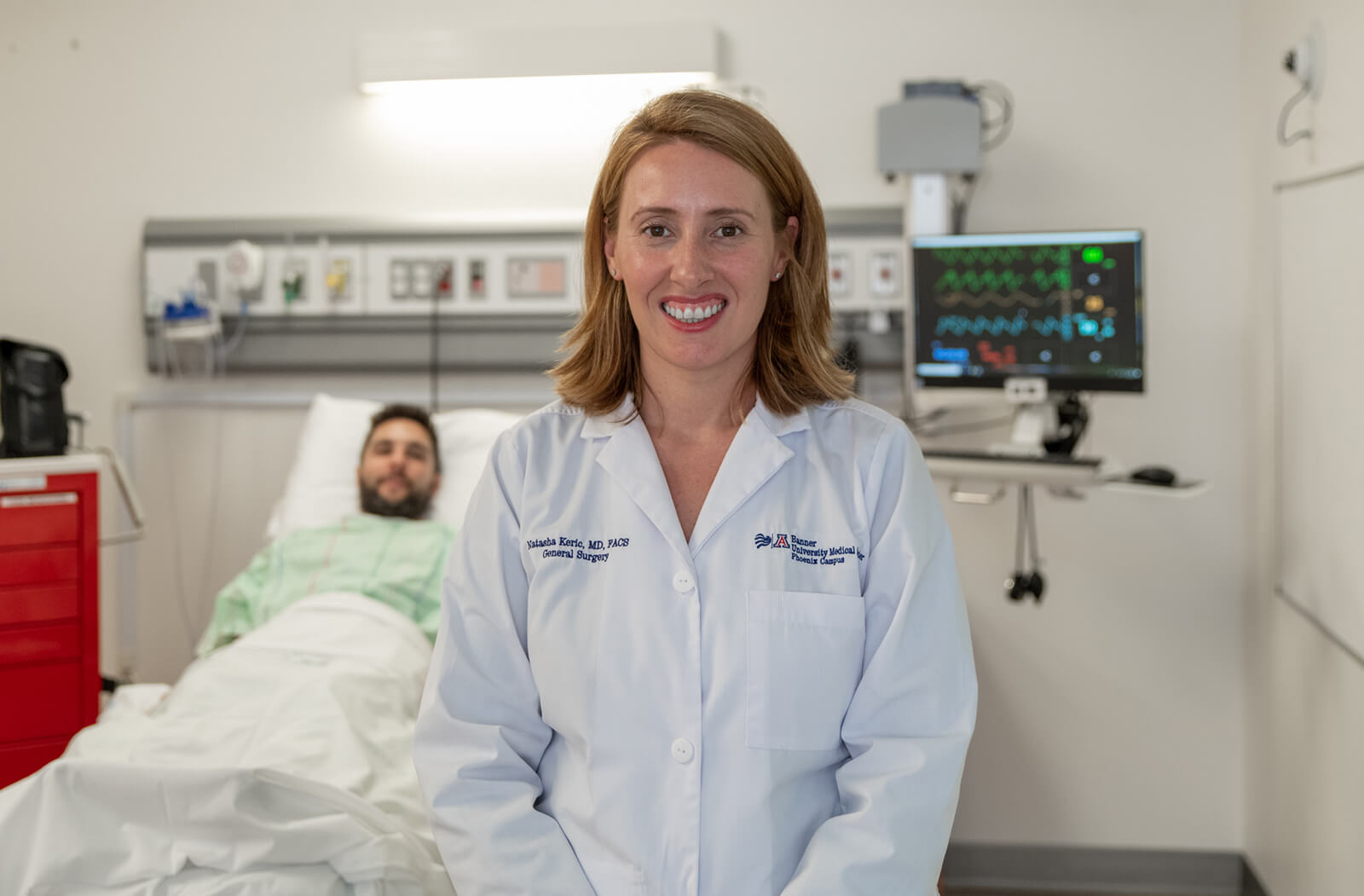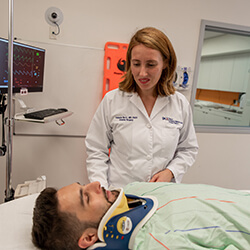
Physician Changes Cervical Spine Clearance Protocols

Natasha Keric, MD, is hoping to improve quality of care, reduce length of stay and limit adverse outcomes for adult trauma patients with potential cervical spine injuries. Dr. Keric developed a practice management guideline in 2016 that has been implemented at Banner Health hospitals that allows physicians to remove cervical collars in a safe and timely fashion. Her current research is analyzing the use of this standardized practice to help improve clinical outcomes.
Dr. Keric is the surgery clerkship director at the University of Arizona College of Medicine – Phoenix and a trauma, acute care and critical care surgeon at Banner – University Medical Center Phoenix. She is working on this research with Patrick Bosarge, MD; Andy Tang, MD, and Bellal Joseph, MD. The research is supported by a seed grant awarded by the Department of Surgery at the College of Medicine – Phoenix.
Explain Your Research

How Did You Become Interested in this Subject?
In 2016, we had a patient who had a collar on and developed a pressure ulcer. There was an initiative from the nursing side that wanted to study why this patient got this type of pressure ulcer, and they wanted a physician champion. When I got involved, it prompted me to review the case, analyze our current process, delve into the literature and see if this could have been prevented. With the many controversies surrounding clearance of the cervical spine collar, it quickly became not only a research project, but passionate interest for me. I had the opportunity to work with Dr. Tang, trauma medical director at Banner – University Medical Center Tucson in developing this joint protocol.
What is the Background of Cervical Spine Clearance?
Placing cervical collars on adult patients with blunt traumatic injury has been in practice for about 30 years. The rationale behind the practice was to immobilize the cervical spine in patients in the pre-hospital setting if there was a suspicion for a cervical spine injury and to prevent secondary injury. The conundrum, however, is what to do with the collar once the patient arrives to the trauma center. Missed cervical spine injuries in the setting of improperly placed or removed cervical collars lead to devastating neurologic sequalae. Cervical collar clearance is therefore, a very important and vital decision for trauma surgeons in the initial evaluation of patients.
Why are Surgeons Hesitant to Clear a Cervical Collar Even with Imaging that Does Not Suggest a Cervical Spine Injury?
There has been a lot of research on how to clear a cervical collar when there is no apparent cervical spine injury. When a patient presents to the trauma or emergency department, the provider will perform a clinical exam and determine if there is a cervical spine injury. If a cervical spine injury is suspected or the patient is not able to be clinically evaluated, because they are intoxicated or obtunded, then a CT scan of the cervical spine is indicated. There have been numerous multicenter trials and studies that show that use of CT scans has 100 percent sensitivity in detecting bony spine injuries. Essentially, if the CT scan is negative, you can assume that there is no cervical spine injury and the cervical collar can be removed.
Despite the evidence and quality of CT scans for cervical spine injury detection, there is still a fear based on anecdotal evidence that we might be missing that one patient who has a cervical spine injury despite negative imaging. That’s where my research comes in. I am trying to prove that a standardized practice guideline that employs a safe and evidence-based approach to clearing cervical spine collars in adult patients with blunt traumatic injury will help mitigate complications and improve clinical outcomes, decrease hospital length of stay and costs of adjunctive tests.
How Could Fully Implementing this Protocol Improve Patient Care?
This standardized practice will help mitigate complications such as neurologic sequelae, delay in definitive treatment, increased hospital costs, prolonged patient immobilization, discomfort and unnecessary and costly adjunctive testing like an MRI. An MRI is a great adjunctive imaging exam to evaluate cervical spine injury. The pros of an MRI exam are that it is highly sensitive and specific in detecting any cervical spine and ligamentous injury. However, there are a lot of cons that include cost and contraindications, such as previously placed hardware and patient comfort with being in a claustrophobic space that would preclude many patients in having the test performed. Inability to obtain MRI imaging then leads to the collar being in place for longer periods of time, which leads to prolonged hospital length of stay and complications such as pressure ulcers. It becomes somewhat of a cycle, which is what our research is trying to break. We want to show that high quality CT, coupled with a good clinical exam, is crucial. Additionally, the use of selective MRI imaging is more cost effective in detecting significant cervical spine injury, allows for safe removal of cervical spine collars and improves overall care of our trauma patients.
About the College
Founded in 2007, the University of Arizona College of Medicine – Phoenix inspires and trains exemplary physicians, scientists and leaders to optimize health and health care in Arizona and beyond. By cultivating collaborative research locally and globally, the college accelerates discovery in a number of critical areas — including cancer, stroke, traumatic brain injury and cardiovascular disease. Championed as a student-centric campus, the college has graduated more than 800 physicians, all of whom received exceptional training from nine clinical partners and more than 2,700 diverse faculty members. As the anchor to the Phoenix Bioscience Core, which is projected to have an economic impact of $3.1 billion by 2025, the college prides itself on engaging with the community, fostering education, inclusion, access and advocacy.


